What does a day in my life as a grant writing consultant look like?
To be honest, it has changed a lot since I had a baby last fall and even more since the quarantine. But those are factors that many of you might also be dealing with right now, and regardless of what’s going on in the world, I’m still doing the same tasks, just fewer of them.
Morning
Wake up, have coffee, write in my journal, read, and plan my top 3 priorities for the day. Then get dressed. (This only happens if I get up before he does. If not, then I do it during his first nap.)
Wake baby and do his morning routine.
Reply to emails and social media comments and messages. Often as I do that, I find other things to do, little admin things like change something in an email sequence, improve how I explain something on our course site. As you grow your online presence, this can get time-consuming.
This takes at least 2 hours a day for me now. Often I’m also playing with the baby while doing this.
Put baby down for his first nap.
Check my bank account and payment processors. Review my budget for the month and make sure I’m on track. Do other admin work on my courses, write blog posts, email newsletters, and social media posts.
Late Morning
Get baby up and go for an hour to hour and a half family walk.
Afternoon
Feed baby. Put him down for a second nap. Eat lunch.
Do client work, if I have it. Otherwise, do projects for my courses, like creating new resources or promotional materials.
I like to spend at least one hour at a time working on projects. That can be hard to do for me in the morning when I’m getting caught up on all the emails I’ve received from the day before, so I like to do it while the baby is napping (right now he still naps 1.5 hours at a time).
But, when I have a big project and a looming deadline, I might spend an entire day or multiple days in a row only working on that and have my husband be the primary caregiver while I write.
Last week, I had to ask my husband to be the primary caregiver for 3 full days in a row because I had a big project due. Luckily, he’s a professor who is currently working from home and has a flexible work schedule. But when you’re writing grants, your schedule often depends on your clients’ availability and application deadlines.
I do like batching work when I can so that I don’t have to remind myself where I last left off on a project. I just get in there and get it done. Some days I’ll just do an hour of work for one client, an hour of work for another, and so on. It just depends on what’s due when and what’s a priority.
The afternoon is also when I take meetings. I’ve learned that I do not like morning meetings, so I only open my calendar up for afternoon meetings unless I have a special request from someone who can’t make afternoon meetings.
Then I hang out with the baby after his second nap if time allows (most days, it does). Sometimes I’ll be playing with him on the floor or nursing him and working on my laptop at the same time.
Evening
If I have any pressing client work that still needs to be done after the baby gets up from his third nap (ends at 5 pm), I usually do it after he goes to sleep for the night. There’s just too much going on with him in the late afternoon (dinner, bath, reading, etc.) to get any work done.
That’s it for my schedule! Now I want to explain a bit more about what I mean when I say I’m doing a certain task like client work or social media. So in the next section, I’m going to explain the most common tasks I do as a grant writing consultant.

Client Work
I think one common misconception about being a grant writing consultant is that it’s all client work, all the time. The truth is, client work might only take up half of your time, say 20 hours a week if you’re working a 40-hour a week schedule. (Probably way less during a pandemic.)
But that is as it should be, and that also means you have to charge enough to only be working half of your time.
As a grant writing consultant, client work is pretty straightforward. You’re usually going to be looking for grants, evaluating grant opportunities, or writing, revising, and submitting grants. And communicating with your clients, whether via phone, Zoom, or email about those grants, is also a huge part of the job. So being patient, clear, and thorough is key.
These days, client work takes up even less time for me because I focus so much on teaching grant writing in my courses. However, there are certainly days where my entire day is client work and the only other work I do is answering a few student emails and Facebook messages here and there.
I love doing client work, but I also love doing the other parts of my business. And honestly, that’s kind of a prerequisite or something you’ll have to be able to tolerate if you want to have a successful grant writing consultancy.
Emails
I’ve already mentioned client emails, but you might also think about setting aside a certain amount of time at a certain time of the day to answer prospective client inquiries and deal with vendors (for me that means any emails about the software I use, e.g. troubleshooting, changing plans, etc.), or answer or write any other emails that you need to do. One thing I’ve found is hugely detrimental to my productivity is having my email tab open all day. When I have to get down to writing, either for client work or my blog, for example, I close those tabs.
Meetings
You might not be so surprised to know that a lot of working with clients is meeting with them, either face-to-face or via Zoom. Setting up client meetings or prospective client meetings can take a lot of time. I’m so not a fan of the back and forth emails trying to find a time that works for both of us. So I use Acuity scheduling. If someone wants to get on my schedule, I send them the appropriate link. If I want to get on someone’s schedule, I use their link. It’s definitely worth the $10 a month. This will minimize the amount of time you spend on this, but it’s still something to consider as part of your day. Every morning, as part of my daily admin tasks, I check my calendar to see who’s on my schedule. Then we have the meeting, I take notes, and send them to the client afterward along with any documents or reminders about upcoming action items.
Financials
I’ve finally come to enjoy checking my financials on a daily, weekly, monthly, quarterly, and annual basis. I check on different things and run different reports depending on the time period. So set aside at least an hour a week to check on things like invoicing, categorizing expenses, setting aside money for different purposes, paying contractors, etc. (I use the Profit First method to split my business funds over 5 different checking and savings accounts.) Even when you’re just starting up and have very little funding, knowing your numbers, planning, and following your plans every week is necessary for success. Your numbers will guide your decisions every day.
Prospect Research
I used to do a lot of prospecting, but I don’t so much anymore. However, I would search nonprofit membership websites, make spreadsheets, write individualized emails, and send no less than 5 emails to one prospect until I gave up (really, just put them on the “not interested” check again in a year list). Sometimes people ignore you, sometimes they agree to meet with you, sometimes people tell you to leave them alone. I eventually developed such a good email sequence that I got a lot of responses and clients from it. (It also helped that I learned about each nonprofit I was emailing and offered them some free info tailored to their organization.
Marketing
Marketing will look different from consultant to consultant. When I first opened my business, I started a blog, Facebook page, and newsletter. And that’s really all you need when in the beginning—something to say and a place to publish and promote it.
I try to get out a new blog post and newsletter once a week. That also means doing the social media posts promoting the blog post. I used to have someone help me with this because it is time consuming. If you’re going to go this route to market your services, I would set aside at least 5 hours a week to do it. When you’re just getting started, you might set aside even more time as you get familiar with the software and processes.
Miscellaneous Tasks
New things like ideas you want to research or tactics you want to implement are going to come up every week, so set aside a few hours for that. I call this CEO time. It’s the time you take to think about how to scale your business, improve client experience, or come up with a new offering.
It’s important to keep some down time and flexibility in your schedule. So leave some “blank space” time every week. You never know when a new client project can pop up or a new idea just has to be put to paper.
Thanks for reading, and if you’re interested in learning how I established and scaled my grant writing consultancy over the last 5 years, my Grant Writing Consulting Mini-Course registration is now open!






